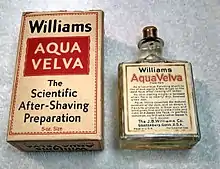Aftershave
Aftershave is a product applied to skin after shaving. Traditionally it is an alcohol based liquid (splash), but it can be a lotion, gel, or even a paste.

It often contains an antiseptic agent such as denatured alcohol, stearate citrate or witch hazel to prevent infection of cuts, as well as to act as an astringent to reduce skin irritation. Menthol is used in some varieties as well to numb irritated skin.
An alcohol-based aftershave usually causes an immediate stinging sensation after applying it post-shave, with effects sometimes lasting several minutes,[1] but most commonly only for seconds. For this reason, a market consisting of highly differentiated products has been created—some using alcohols, some not.
Aftershave balms are frequently recommended for winter use as they tend to be alcohol free and lotion-like, moisturizing the skin.
Some aftershaves use fragrance or essential oil to enhance scent. Moisturizers—natural and artificial, are often touted as able to soften the skin.
Aftershave is sometimes mistakenly referred to as Eau de Cologne due to the very similar nature of the two products. Some aftershave manufacturers encourage using their fragranced aftershave as if it were cologne, in order to increase sales by encouraging consumers to use it in a more versatile manner, rather than just after a shaving session. Some aftershaves were inspired by a cologne.
Early aftershaves included witch-hazel and bay rum, and have been documented in shaving guides.[2] Both still are sold as aftershaves.
See also
| Wikibooks has a book on the topic of: Shaving |
References
- "Soothe Yourself". GQ. Archived from the original on 23 November 2007. Retrieved 2007-11-08.
- "Shaving made easy; what the man who shaves ought to know .. : 20th century correspondence school, New York. [from old catalog] : Free Download & Streaming : Internet Archive". 2001-03-10. Retrieved 2012-10-20.
External links
 Media related to Aftershaves at Wikimedia Commons
Media related to Aftershaves at Wikimedia Commons